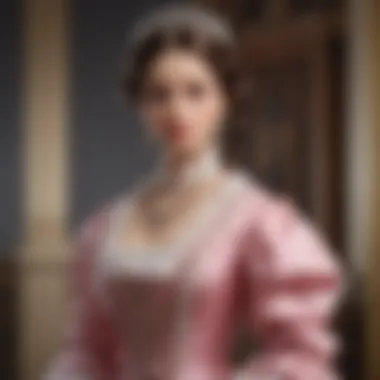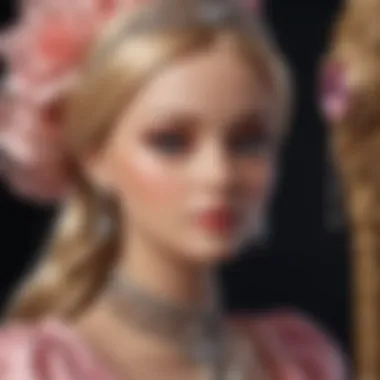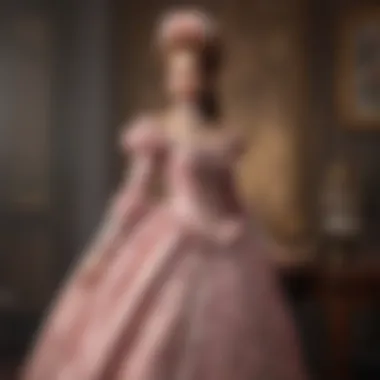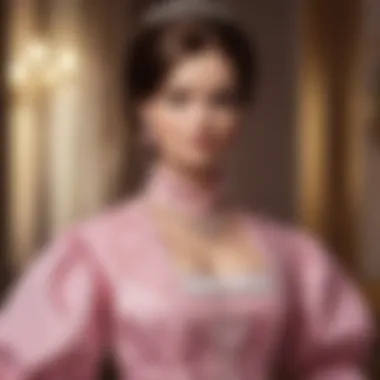Victorian Lady Barbie: Fashion Meets Feminine Ideals


Intro
The Victorian Lady Barbie stands as a fascinating emblem of fashion and societal expectations, bridging the gap between the historical intricacies of the Victorian era and the playful essence of modern dolls. This section aims to unpack the myriad layers of meaning imbued in this doll, highlighting its role not only as a toy but as a mirror reflecting the norms and ideals surrounding femininity throughout history.
In this exploration, we’ll look beyond just the surface design. We’ll consider how the fashion trends of the past inform current perceptions of womanhood and style. The unique clothing, accessories, and aesthetics of the Victorian Lady Barbie prompt reflections on the societal roles that women occupied during that time.
As we take a closer look at how this doll incorporates various elements of design, we’ll understand the implications of such representations in the context of contemporary culture. Join us as we delve into the fashion trends, cultural significance, and consumer perception that define the Victorian Lady Barbie. Through this voyage, we aim to illuminate the underlying messages that shape the portrayal of femininity today.
Prologue to Victorian Lady Barbie
The Victorian Lady Barbie represents more than just a toy; it's a charming reflection of a complex interplay between fashion, society, and evolving ideals of femininity. Not only does it encapsulate intricate design inspirations from the Victorian era, but it also serves as a window into the lifestyle and values of its time. Understanding this doll's design is key to grasping how societal norms shape personal identity and collective consciousness.
This section delves into the historical significance of the Barbie phenomenon while examining how the Victorian aesthetic threads through the fabric of modern toy design. By weaving together contextual history and stylistic elements, we can appreciate why Victorian Lady Barbie matters, both aesthetically and culturally.
Historical Context of Barbie
Barbie was introduced to the world in 1959, a time when women were beginning to redefine their roles in society. She quickly grew to symbolize a myriad of ideals—from career aspirations to unattainable beauty standards. The Victorian Lady Barbie, in particular, channels the timeless elegance and complex social fabric of the Victorian era, which flourished from 1837 to 1901.
During this period, the perceptions of women were undergoing significant changes, mirroring shifts in fashion, art, and societal values. Dolls like Barbie often reflect these evolving narratives, holding up a mirror to the aspirations and limitations faced by women through the ages.
The very first Barbies were sleek and sophisticated, much like the Victorian ladies they evoke. The historical significance of this doll can't be overstated; it connects contemporary experiences with those of yesteryear, shedding light on how fashion influences and reflects identity across generations.
Victorian Aesthetics
Victorian aesthetics are rich and layered, an artistic tapestry infused with grandeur and strict societal expectations. During the Victorian era, the prevailing fashion favored modesty intertwined with intricate detail. Women’s clothing was characterized by voluminous skirts supported by crinolines, fitted bodices, and elaborate accessories, all designed to showcase their femininity without revealing too much skin.
The Victorian Lady Barbie captures these trends, donning outfits that feature sweeping fabrics and delicate embellishments—an incredibly exaggerated portrayal of the femininity expected at that time. These details reveal how fashion was not merely about clothes but a language in itself, embodying grace, propriety, and occasionally, resistance to prevailing norms.
In summary, the Victorian Lady Barbie isn't just an antique doll; it presents a striking fusion of historical elegance and modern-day interpretations of femininity. As we proceed, the various design elements and cultural implications will unravel, providing deeper insight into the layers of meaning nestled within this iconic figure.
The Victorian Era: A Reflection of Society
The Victorian Era, spanning from 1837 to 1901, was a remarkable period that influenced various aspects of life, from fashion to social norms. Exploring this era gives crucial insights into how Barbie, specifically the Victorian Lady Barbie, embodies these historical contexts. The societal norms of the time were complex, dictating not only the fashion but also the roles women occupied, which is essential to understanding the nuances of the doll's design and its broader cultural implications.
Women's Roles in Victorian Society
In the Victorian age, women were often seen through a lens of domesticity. They were expected to adhere to strict ideals of virtue and femininity, predominately confined to the home. The "Angel in the House" concept portrayed women as self-sacrificing and nurturing, supporting their husbands while raising children. While these roles seem restrictive, there was an undercurrent of agency as women sought ways to express themselves within these confines. Many took up charitable work and engaged in writing, crafting a sense of community and sharing their voices.
This unwavering expectation was mirrored in the fashion of the time, especially in how women adorned themselves. Dresses were often designed to emphasize a woman's status, joyfully showcasing intricate embroidery and rich fabrics. The Victorian Lady Barbie, in this light, serves as a conduit to represent these ideals. Her attire reflects both the aspirations and constraints placed upon women during that time.
Fashion Trends of the Time
The fashion trends of the Victorian era remain telltale symbols of societal values, showcasing the intersectionality of identity, status, and femininity. The opulence and structure in women’s clothing reveal not just aesthetic preferences but also larger narratives about gender roles.
Silhouettes and Structures
The silhouettes of the Victorian period were grand and exaggerated, often characterized by tight bodices and voluminous skirts supported by crinolines. This form represented, in a way, the societal expectations laid upon women. The design choices favored a particular type of femininity, one that was both delicate and powerful.


The key characteristic of these silhouettes was their ability to dramatically alter a woman's shape and presence. Instead of merely dressing, women were required to embody the role of the ideal lady. The distinctive tightness around the waist combined with the voluminous skirts created an almost theatrical figure that drew eyes and attention.
One unique feature of these structures was their practical disadvantage. The structured garments, while visually appealing, could hinder movement and comfort. For instance, the rigid crinoline offered no space for spontaneity and was far from the liberties women enjoyed later on. Nevertheless, in examining Victorian Lady Barbie, one can appreciate how these silhouettes have been reinterpreted in the toy's design, combining nostalgia and modernity in fashion.
Color Palettes and Fabrics
Victorian fashion was equally defined by its rich color palettes and luxurious fabrics. Deep hues like burgundy, forest green, and navy blue were common, often used to signify wealth and status. The fabric choices—satin, velvet, and lace—added layers of complexity and extravagance, emphasizing the significance of appearance in that society.
The distinctive use of color affected societal perception, illustrating how fashionable choices became intertwined with social identity. A prominent piece in a lady's wardrobe was the silk gown, which often conveyed both elegance and importance in social gatherings.
However, this beauty was not without drawbacks. Silk and heavy fabrics could be cumbersome, particularly in warmer months, leading to discomfort. As a result, while these elements served the aesthetic of the time, they also mirrored the constraints placed on women—simultaneously beautiful yet impractical. The Victorian Lady Barbie encapsulates this charm, drawing from historical trends while sparking conversations about femininity and identity in today’s world.
"Fashion is the armor to survive the reality of everyday life."
— Bill Cunningham
The Victorian Lady Barbie thus becomes more than a mere doll; it embodies a historical reflection of society’s expectations and the intricate fabric of life woven around themes of femininity and identity.
Design Elements of the Victorian Lady Barbie
Design elements play a pivotal role in bringing the Victorian Lady Barbie to life, transforming a mere doll into a vessel of history and culture. Each aspect of its design—whether it’s the attire, the accessories, or the packaging—reflects not only the sartorial trends of the Victorian era but also encapsulates the ideals of femininity prevalent in that time. The attention to detail in these design elements is what engages collectors, historians, and fashion enthusiasts alike.
Attire Inspirations
The Victorian Lady Barbie dazzles with a wardrobe that draws inspiration directly from the clothing worn by women in the Victorian period. An authentic Victorian outfit consisted typically of voluminous skirts, fitted bodices, and elaborate trims. For Barbie, these features are translated into miniature forms with precision.
- Silhouettes: The doll sports a striking hourglass silhouette, echoing the popular styles of the time. The skirts often have multiple layers, reminiscent of petticoats that would have been essential in creating the iconic shape.
- Fabrics and Colors: Fabrics tend to mimic luxurious materials like silk and velvet, in addition to using rich color palettes, such as deep burgundies and forest greens, paired with pastel shades. The idea here is to reflect both the vibrancy and the modesty characteristic of Victorian fashion.
This thoughtful selection of attire helps to link contemporary culture with the traditions of the past, making the Victorian Lady Barbie more than just a mere toy. It acts as a charming representation of a complex era.
Accessories and Details
Accessories in the Victorian Lady Barbie's ensemble elevate its sophistication. Each piece is carefully curated, aiming to provide a comprehensive aesthetic experience.
- Jewelry: The inclusion of ornate necklaces and jeweled hairpieces adds an aristocratic flair that was often associated with affluent Victorian women. These accessories are not just decorative; they are symbols of social status.
- Handbags and Gloves: Small handbags, often made of intricate materials, and lace gloves are quintessential elements of Victorian attire. They perfectly embody the period's expectation of decorum and elegance.
In opening a beautifully designed box, the viewer is greeted not just by the doll, but by a world where every tiny accessory tells a story, enriching the representation of Victorian ideals of femininity.
Artistry in Packaging
The packaging of the Victorian Lady Barbie is more than a means to store or display the doll; it is an art form all on its own. The packaging is designed to capture the essence of the Victorian aesthetic.
"The right packaging can elevate a product from simple toy to collectible artifact."
- Visual Appeal: The exterior often features ornate patterns and typography that mimic the styles of Victorian graphic design. This strategic use of design both catches the eye and tells a story before the box is even opened.
- Materials: High-quality materials are frequently utilized in the packaging, providing a tactile experience that resonates well with the target audience. The materials used evoke a sense of nostalgia and elegance, aligning perfectly with the time period being represented.
In essence, the artistry of packaging ties all elements together, offering an engaging experience that invites consumers to admire the Victorian Lady Barbie as a piece of art that stands at the intersection of fashion, history, and identity.
Cultural Significance of the Victorian Lady Barbie
The Victorian Lady Barbie transcends mere playtime; it's a reflection of historical contexts and societal shifts. In this piece of plastic, we see not only a representation of fashion but also an embodiment of feminine ideals that have evolved over the decades. The cultural significance of this doll lies in its ability to spark conversations around gender roles, identity, and the ever-changing narrative of womanhood throughout history.


Symbolism of Femininity
Diving into the symbolism embedded in the Victorian Lady Barbie, one can’t ignore how this doll encapsulates the intricate dance of femininity. She serves as a canvas showcasing the Victorian ideals where women were often seen as symbols of virtue and domesticity. This duality—appearing delicate yet also embodying strength—reveals how women of the era were stereotyped yet had to navigate complex realities that demanded resilience.
In essence, the Victorian Lady Barbie serves as a reminder that femininity is multifaceted. She represents not just the frills and lace but also the quiet strength that lies beneath. This doll provokes thought about how society continues to frame the narrative surrounding femininity and what it means in today’s context.
"The Victorian Lady Barbie is a bridge between bygone eras and contemporary femininity."
Consumer Perception and Impact
As we peel back the layers of consumer perception, it becomes evident the Victorian Lady Barbie influences more than just the toy market. It shapes the identities of those who play with her. The perception of this doll has a ripple effect on market dynamics, aligning closely with the cultural shifts in how femininity is envisioned.
Market Trends
Looking at the market trends, there's a noticeable inclination towards dolls that reflect diverse backgrounds, body types, and ideals. This evolution is not only a savvy business maneuver but also a response to the public’s appetite for representation and inclusivity. The Victorian Lady Barbie fits into this tapestry beautifully albeit with a historical edge.
One key characteristic of market trends surrounding this doll is nostalgia. Marketers leverage this sentiment, harnessing the allure of the Victorian era while pulling at the strings of memory for those who grew up with the Barbie line. From collectors to casual buyers, the Victorian Lady Barbie has found a sweet spot in the market, emerging as a desirable piece for those enamored by history and fashion.
Target Demographics
When discussing target demographics, we see a blend of both young audiences and adult collectors showing interest in the Victorian Lady Barbie. This doll appeals to children through the lens of imaginative play while also captivating older enthusiasts who appreciate the artistry and cultural context behind her design.
A notable aspect of the target demographic is its diversity in age and gender. Though traditionally seen as a "girl’s toy," the increased visibility of dolls that celebrate various narratives invites all children, regardless of their background, to engage. This isn't just a toy for girls to play with; it's a narrative, an exploration of identity, and a conversation starter about past and present gender roles.
The Intersection of Fashion and Identity
Fashion is not merely about fabric and cuts; it’s a reflection of identity, values, and aspirations. In exploring the Victorian Lady Barbie, it becomes clear just how intertwinned fashion and identity are, especially in the context of cultural narratives surrounding femininity. The historical piece captured in this doll goes beyond a plastic figure; it engages with the question of how personal and societal identities are shaped.
Fashion as Expression
Fashion serves as a canvas, where individuals paint their stories - stories steeped in personal choices and collective history. This Victorian Lady Barbie exemplifies how style can convey messages about who we are or wish to become. It's not just a plaything; it's an embodiment of a time when fashion was an essential part of a woman’s identity. The intricate details of her dress speak volumes, illustrating the complexities of personal expression within the rigid confines of the Victorian ideals.
Thinking through the lens of fashion, we see that every stitch and drape in the doll’s attire encapsulates the essence of an era that prized elegance paired with gender roles. By wearing these garments, playtime for many young girls became a stage where they could cloak themselves in the sophistication that Victorian society celebrated, albeit flowered by their imagination.
The Role of Dolls in Shaping Identity
Representation in Play
The act of play is not simply for entertainment; it's a valuable process of growth. When children engage with dolls like the Victorian Lady Barbie, they aren’t just acting out stories—they’re navigating the waters of identity. This specific aspect, that dolls allow for imaginative representation, helps children explore various social dynamics and roles that exist in the adult world. The Victorian Lady Barbie, in particular, stands as a symbol of historical feminine ideals, showcasing grace, beauty, and societal expectations.
Having a doll that embodies these characteristics allows children to delve deeper into not just who they are but who they could potentially become. It's compelling to see how these dolls, pivotal to childhood play, serve as sources of inspiration. They act almost as guides, reflecting deep-seated cultural values while offering children a space to fantasize and practice their understanding of identity.
- Key characteristic: The doll offers a representation of femininity from a historical perspective.
- Benefits: It enables young girls—and even boys—to step into roles that challenge modern norms and highlight the various dimensions of identity.
- Unique feature: This doll's history transforms it into more than a toy; it becomes a medium for exploring complex ideas of womanhood.
However, it's important to approach this with a critical lens. Not all notions of identity presented through dolls may resonate positively in today’s context. The rigid beauty standards and roles can sometimes reinforce stereotypes, which might not be beneficial for nurturing more progressive ideals.
Influence on Self-Image
The broader narratives around dolls also extends to how they foster or hinder self-image. When children play with the Victorian Lady Barbie, they might find themselves affected by the standards the doll represents. This lead us to consider how influential these objects can be—their impact extends beyond mere aesthetics. Here, the key characteristic is that dolls can mirror societal expectations that kids are often grappling with.


- Beneficial point: The doll can serve as a way for children to affirm aspects of their identity or aspire towards their visions of beauty and success.
- Unique feature: The intersection of history and play allows young children to contextualize their understanding of self, making it a rich experience.
Though on the flip side, there are disadvantages—the same ideals that inspire can also breed feelings of inadequacy or unrealistic aspirations when children compare themselves to dolls. Thus, it surfaces crucial conversations about how we view and process our identities in the light of societal standards.
"Fashion is a way to say who you are without having to speak."
Barbie's Evolution Through the Ages
Barbie, a symbol of pop culture, has gone through many transformations since her debut. The Victorian Lady Barbie sits at a unique intersection of historical fashion and contemporary ideals. Understanding her evolution is essential, as it highlights how women’s roles and societal expectations have shifted over the decades. As we navigate through these changes, we see Barbie adapting to reflect modern sensibilities while maintaining a connection to the past.
Adapting to Modern Sensibilities
The Victorian Lady Barbie showcases a beautiful blend of retro elegance and modern-day contexts. In the past, Barbie often reflected societal norms of femininity, primarily focusing on beauty and domestic roles. However, as the decades rolled by, this representation began to evolve.
Today, Barbie's design decisions are influenced by discussions around body positivity and inclusivity. The Victorian Lady Barbie, while adorned in elegant Victorian garb, also embraces diverse body types and backgrounds, encouraging girls everywhere to embrace their unique selves.
- Empowerment Through Diversity: The modern interpretation of Barbie encourages a narrative that women can be anything they desire, even if it's a Victorian lady in a lavish dress.
- Cultural Relevance: These shifts in design and character helps reflect women’s independence and aspirations, challenging outdated stereotypes.
This adaptability is not simply a marketing strategy but an acknowledgment of the changing roles women occupy in society, allowing the doll to resonate with contemporary audiences.
Contemporary Interpretations of Victorian Styles
The charm of the Victorian Lady Barbie lies in how it reimagines classic fashion for today's audience. Designers take cues from the distinctive Victorian styles, incorporating intricate details, bold colors, and historical accuracy, yet these elements are presented in a way that feels fresh and relevant.
- Retrofuturism in Fashion: Mixing old-world elegance with modern fabrics creates a unique product that speaks to both nostalgia and today’s style.
- Variety and Selection: Recent collections often feature multiple dolls with different outfits, allowing collectors and children alike to explore various facets of Victorian fashion.
"The Victorian Lady Barbie serves as a canvas where past and present come together, allowing for a richer narrative around femininity and fashion."
Barbie's evolution is not just about changing styles; it's about conveying deeper messages regarding women's empowerment and the multifaceted nature of identity in a rapidly changing world. The Victorian Lady Barbie stands as a testament to how far we've come while reminding us of our roots, making it a vital player in the sphere of both fashion and cultural symbolism.
Culmination: The Lasting Legacy of Victorian Lady Barbie
The Victorian Lady Barbie stands as a remarkable intersection of fashion, history, and cultural expression. Its ability to encapsulate the grace of a bygone era while still resonating with contemporary ideals demonstrates the versatility of this doll. The careful design decisions and the historical context behind the Victorian Lady Barbie reveal layers of meaning that go beyond mere play.
One significant aspect of this doll is how it reflects changing feminine ideals. In the Victorian era, women were often confined by societal expectations, their roles narrowly defined by strict codes of conduct and appearance. The Victorian Lady Barbie offers a glimpse into this complex web of expectations through its elegant attire and refined details, all while allowing today's children and collectors to engage with a history once seen through a rather rigid lens.
Monsieur Barbie's influence extends beyond nostalgia; she serves as a catalyst for discussion about femininity and identity. By representing both the beauty and the constraints of her time, the Victorian Lady Barbie provides an avenue to explore how far society has come in redefining women's roles and aspirations.
"The significance of dolls, especially those with such historical roots, lies not merely in their aesthetics but in their ability to challenge perceptions and provoke thought."
In essence, reflecting on the Victorian Lady Barbie enables us to examine the cultural messaging surrounding women and fashion. It’s a complex dance of admiration and critique, inviting dialogue on how these themes persist or dissolve in the fabric of modern society.
Reflecting on Feminine Ideals
At the core of the Victorian Lady Barbie lies a dialogue about feminine ideals entrenched in both admiration and criticism. Traditionally, the image of a Victorian woman has been marred by notions of fragility and dependence. Yet, this doll subverts those ideas by embodying a certain fortitude. Her attire, though ornate, serves as armor against societal critiques, empowering young girls to embrace qualities of strength and elegance.
The Victorian Lady Barbie invites contemplation of how these ideals have shifted through time. In the past, women were tools of their social class; today, they scream resilience, driven by ambition and individuality. The power of this doll lies in its ability to mirror the societal landscape, showing that femininity can be multifaceted and dynamic—much like the women it aims to represent.
Cultural Relevance in Today's Society
In today's culturally diverse landscape, the Victorian Lady Barbie thrives as a symbol of the evolution of women's roles. While still holding onto the elegance of vintage style, she also reflects ongoing discussions about identity, power, and self-expression. The diverse interpretations of Victorian styles seen in various fashion circles today showcase that the essence of this doll resonates well beyond childhood play.
The discussions around Barbie, particularly the Victorian version, serve to highlight pressing issues such as representation and self-image. There’s a greater awareness about how culture influences identity formation, especially among young girls navigating social stereotypes.
The lasting legacy of the Victorian Lady Barbie lies in its invitation to celebrate femininity in all forms, bridging past and present and facilitating a richer understanding of what it means to be a woman in any era. As we navigate a world still grappling with gender norms, this doll stands tall—a curiosity that transcends simple play, challenging both children and adults alike to think critically about style, identity, and societal constructs.



